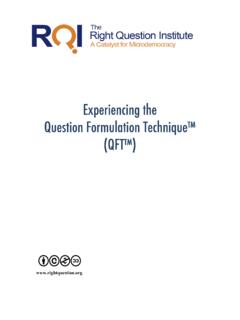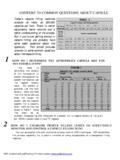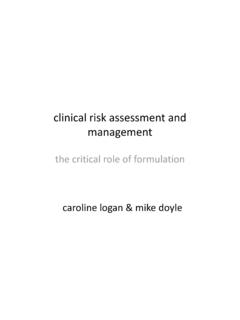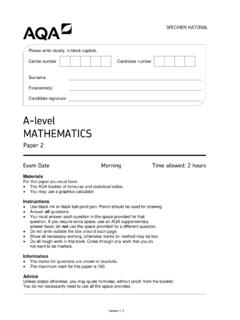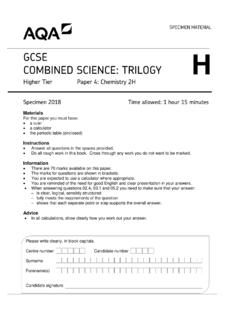Transcription of API Synthesis and Formulation
1 2009 Supplement to the September 2009 IssueAPI Synthesis and FormulationEUROPEDrug deliveryrug development is an arduous, financially risky pro-cess that has been estimated to cost pharmaceutical firms an average of $802 million for each therapeutic gaining marketing approval (1). To maximize return on the initial investment, companies look to strengthen their market position and extend product life cycles through reformulations, new routes of administration, and use of the latest technology. For injectable therapeutics, one way to accomplish this goal is to move a product s presentation from a vial to a prefilled sy-ringe.
2 A prefilled syringe helps to increase dosing accuracy, con-venience, and safety; enhance patient quality of life; and reduce patient time in the clinic. While the introduction of prefilled syringe presentations varies among drug classes and therapeutic categories, the overall market for prefilled syringes is expected to grow by per year (see Table I) (2). This article presents a project manager s perspective on the rationale and timeline for moving an injectable therapeutic to a prefilled-syringe format. The author also discusses a regula-tory strategy that can facilitate a smooth transition to the new dosage and timelineThe natural first question is, Why change a drug s presenta-tion to a prefilled syringe?
3 For many companies, the decision to change to a prefilled-sryinge format is strategic because it meets the demands of physicians and patients looking for easier modes of administration and it helps further differentiate the product from competing drugs in the same therapeutic from Frost and Sullivan, a global market-research firm, demonstrate the importance of product presentation to physi-cians and patients. Three of the top five factors influencing a physician s choice of a drug-delivery type ease of use by patients (16%), convenience (11%), and comfort (9%) are affected by the presentation of the product.
4 Physicians also commonly view pa-tient satisfaction (14%) and a minimum of side effects (9%) as important factors in their choice of drug-delivery methods (3). When selecting a drug-delivery device for their patients, 46% of physicians take into account whether it easily enables self- administration (3). Patients who have a choice between drug- Moving from Vials to Prefilled Syringes A Project Manager s PerspectiveRaul SoikesDeciding to switch an injectable therapeutic s presentation from a liquid or lyophilized vial to a prefilled syringe requires many financial and strategic considerations.
5 The author discusses the complex issues involved in making such a change and describes a potential regulatory strategy, including stability protocols and clinical testing, for getting the newly formatted drug to Soikes is senior director of program management at Baxter BioPharma Solutions, 927 South Curry Pike, Bloomington, IN 47403, tel. , x ProduCtS/get ty ImageSDdelivery devices also judge the ease of self-administration (37%) and whether the product has been recommended by the physician (24%) (4). Prefilled syringes also present economic advantages for pharmaceutical companies marketing injectable therapeutics.
6 Because the devices meet customer demands for increased safety and convenience, companies often are rewarded with premium pricing for prefilled syringes compared with vials (5). Moreover, prefilled syringes help increase the saleable yield of active phar-maceutical ingredient (API). Filling API in prefilled syringes en-ables the required dose to be delivered precisely. Consequently, only trace amounts of API remain in the needle of the prefilled syringe after injection. In contrast, single- or multi-use vials re-quire overfilling the API to ensure that an accurate dose is pulled into the syringe each time.
7 The question of when to move an injectable therapeutic into a new presentation is as significant as the rationale for why. Speed to market is a critical factor for the development of new pharma-ceuticals, as well as for producing reformulations or improved delivery devices. Injectable drugs typically are introduced in a vial, because vials enable a faster pathway to regulatory approval, particularly when individual patient dosing varies according to factors such as age or weight. Once the product is on the market, a reasonable timeline for developing improved packaging depends on whether the initial product presentation is liquid or lyophilized (see Table II) (6).
8 Moving from a liquid vial to a prefilled syringe can be accom-plished within 6 to 18 months in most cases. The timeline is a bit longer for molecules introduced to the market as lyophilized powder. As a consequence, movement to a prefilled syringe from a dry vial typically is considered a mid-term life-cycle strategy. The process of developing a stable liquid Formulation and gaining regulatory clearance for the formula-tion and enhanced packaging may require 18 36 months, and occasionally longer depending on clinical-trial Pharmaceuticals (Petach Tikva, Israel) employed a mid-term strategy in 2002, when it changed the lyophilized vial pre-sentation of Copaxone (glatiramer acetate) into a stable liquid offered in a prefilled syringe.
9 Before reformulation, market share of Copaxone was declining. Yet, the new presentation achieved rapid acceptance in the market; 64% of patients switched to the prefilled syringe version within the first three months of avail-ability. The remainder switched within six months of the new product s launch (6). The Copaxone prefilled syringe had measurable ad-vantages for patients on chronic therapy for multiple scle-rosis, particularly the amount of time required for self- administration. The average time a patient spent preparing for a Copaxone injection was reduced from the 235 s it took to reconstitute the product and draw it into a syringe to 38 s with a prefilled syringe.
10 Consequently, the reformulated version saved a typical patient more than 20 hours over the course of a year. For Teva, increased patient convenience was rewarded with premium pricing, compared with the original Formulation . In 2002, the premium started at 5% and rose to by 2005 (6).Similarly, in 2004, Amgen (Thousand Oaks, CA) changed the Table II: Differentiation of an injectable therapeutic throughout its life cycle. Short-term strategy (6 18 months)Mid-term strategy (18 36 months)Long-term strategy (> 36 months)attach a safety device to a prefilled syringe.
